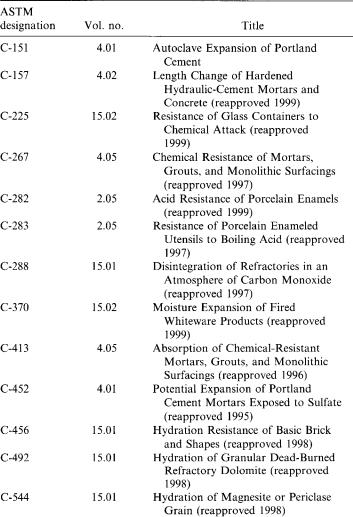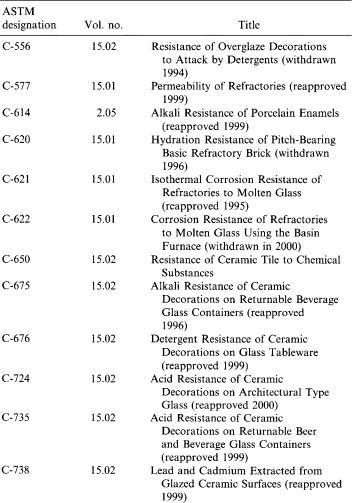
- •Preface to the Second Edition
- •Preface to the First Edition
- •ACKNOWLEDGEMENTS
- •Contents
- •1.1 EXERCISES, QUESTIONS, AND PROBLEMS
- •2.1 INTRODUCTION
- •2.2 CORROSION BY LIQUIDS
- •2.2.1 Introduction
- •2.2.2 Crystalline Materials
- •Attack by Molten Glasses
- •Attack by Molten Salts
- •Electrochemical Corrosion
- •Attack by Molten Metals
- •Attack by Aqueous Media
- •2.2.3 Glasses
- •Bulk Glasses
- •Fiber Glass
- •Bioactive Glass
- •2.3 CORROSION BY GAS
- •2.3.1 Crystalline Materials
- •2.3.2 Vacuum
- •2.3.3 Glasses
- •2.4 CORROSION BY SOLID
- •2.5 SURFACE EFFECTS
- •2.5.1 Surface Charge
- •2.5.2 Porosity and Surface Area
- •2.5.3 Surface Energy
- •2.6 ACID/BASE EFFECTS
- •2.7 THERMODYNAMICS
- •2.7.1 Mathematical Representation
- •2.7.2 Graphical Representation
- •2.8 KINETICS
- •2.9 DIFFUSION
- •2.10 SUMMARY OF IMPORTANT CONCEPTS
- •2.11 ADDITIONAL RELATED READING
- •2.12 EXERCISES, QUESTIONS, AND PROBLEMS
- •REFERENCES
- •3.1 INTRODUCTION
- •3.2 LABORATORY TEST VS. FIELD TRIALS
- •3.3 SAMPLE SELECTION AND PREPARATION
- •3.4 SELECTION OF TEST CONDITIONS
- •3.5 CHARACTERIZATION METHODS
- •3.5.1 Microstructure and Phase Analysis
- •Visual Observation
- •Optical Microscopy
- •X-ray Diffractometry
- •Transmission Electron Microscopy
- •3.5.2 Chemical Analysis
- •Bulk Analysis
- •Surface Analysis
- •3.5.3 Physical Property Measurement
- •Gravimetry and Density
- •Porosity-Surface Area
- •Mechanical Property Tests
- •3.6 DATA REDUCTION
- •3.7 ADDITIONAL RELATED READING
- •3.8 EXERCISES, QUESTIONS, AND PROBLEMS
- •REFERENCES
- •4.1 INTRODUCTION
- •4.2 ASTM STANDARDS
- •4.2.16 Permeability of Refractories, C-577
- •4.2.26 Lead and Cadmium Extracted from Glazed Ceramic Surfaces, C-738
- •4.3 NONSTANDARD TESTS
- •4.4 ADDITIONAL RELATED READING
- •4.5 EXERCISES, QUESTIONS, AND PROBLEMS
- •REFERENCES
- •5.1 ATTACK BY LIQUIDS
- •5.1.1 Attack by Glasses
- •Alumina-Containing Materials
- •Zircon
- •Zirconia
- •Carbides and Nitrides
- •5.1.2 Attack by Aqueous Solutions
- •Alumina
- •Silica and Silicates
- •Concrete, Cement, Limestone, Marble, and Clay
- •Zirconia-Containing Materials
- •Superconductors
- •Titanates and Titania
- •Transition Metal Oxides
- •Carbides and Nitrides
- •5.1.3 Attack by Molten Salts
- •Oxides
- •Carbides and Nitrides
- •Superconductors
- •5.1.4 Attack by Molten Metals
- •5.2 ATTACK BY GASES
- •5.2.1 Oxides
- •Alumina
- •Alumino-Silicatcs
- •Magnesia-Containing Materials
- •Zirconia
- •5.2.2 Nitrides and Carbides
- •Silicon Nitride
- •Other Nitrides
- •Silicon Carbide
- •Other Carbides
- •5.2.3 Borides
- •5.2.4 Silicides
- •5.2.5 Superconductors
- •5.3 ATTACK BY SOLIDS
- •5.3.1 Silica
- •5.3.2 Magnesia
- •5.3.3 Superconductors
- •5.3.4 Attack by Metals
- •5.4 ADDITIONAL RELATED READING
- •5.5 EXERCISES, QUESTIONS, AND PROBLEMS
- •REFERENCES
- •6.1 INTRODUCTION
- •6.2 SILICATE GLASSES
- •6.3 BOROSILICATE GLASSES
- •6.4 LEAD-CONTAINING GLASSES
- •6.5 PHOSPHORUS-CONTAINING GLASSES
- •6.6 FLUORIDE GLASSES
- •6.7 CHALCOGENIDE-HALIDE GLASSES
- •6.8 ADDITIONAL RELATED READING
- •6.9 EXERCISES, QUESTIONS, AND PROBLEMS
- •REFERENCES
- •7.1 INTRODUCTION
- •7.2 REINFORCEMENT
- •7.2.1 Fibers
- •7.2.2 Fiber Coatings or Interphases
- •7.2.3 Particulates
- •7.3 CERAMIC MATRIX COMPOSITES
- •7.3.1 Oxide-Matrix Composites
- •Al2O3-Matrix Composites
- •Other Oxide-Matrix Composites
- •7.3.2 Nonoxide-Matrix Composites
- •Si3N4 Matrix Composites
- •SiC-Matrix Composites
- •Carbon-Carbon Composites
- •Other Nonoxide Matrix Composites
- •7.4 METAL MATRIX COMPOSITES
- •7.5 POLYMER MATRIX COMPOSITES
- •7.6 ADDITIONAL RELATED READINGS
- •7.7 EXERCISES, QUESTIONS, AND PROBLEMS
- •REFERENCES
- •8.1 INTRODUCTION
- •8.2 MECHANISMS
- •8.2.1 Crystalline Materials
- •8.2.2 Glassy Materials
- •8.3 DEGRADATION OF SPECIFIC MATERIALS
- •8.3.1 Degradation by Oxidation
- •Carbides and Nitrides
- •Oxynitrides
- •8.3.2 Degradation by Moisture
- •8.3.3 Degradation by Other Atmospheres
- •Carbides and Nitrides
- •Zirconia-Containing Materials
- •8.3.4 Degradation by Molten Salts
- •Carbides and Nitrides
- •Zirconia-Containing Materials
- •8.3.5 Degradation by Molten Metals
- •8.3.6 Degradation by Aqueous Solutions
- •Bioactive Materials
- •Nitrides
- •Glassy Materials
- •8.4 ADDITIONAL RELATED READING
- •8.5 EXERCISES, QUESTIONS, AND PROBLEMS
- •REFERENCES
- •9.1 INTRODUCTION
- •9.2 CRYSTALLINE MATERIALS—OXIDES
- •9.2.1 Property Optimization
- •9.2.2 External Methods of Improvement
- •9.3 CRYSTALLINE MATERIALS—NONOXIDES
- •9.3.1 Property Improvement
- •9.3.2 External Methods of Improvement
- •9.4 GLASSY MATERIALS
- •9.4.1 Property Optimization
- •9.4.2 External Methods of Improvement
- •REFERENCES
- •Glossary
- •Epilog

4
Corrosion Test Procedures
When you can measure what you are speaking about and express it in numbers you know something about it; but when you cannot measure it, when you cannot express it in numbers, your knowledge is of a meager and unsatisfactory kind.
LORD KELVIN
4.1 INTRODUCTION
The American Society for Testing and Materials (ASTM) was formed in 1898 through the efforts of Andrew Carnegie and the chief chemist of the Pennsylvania Railroad, Charles Dudley, who were both convinced that a solution was necessary to the unexplainable differences of testing results that arose between their laboratories. These early efforts were focused upon
143
Copyright © 2004 by Marcel Dekker, Inc.

144 |
Chapter 4 |
improving the understanding between seller and buyer of the quality of their products. Although ASTM and other organizations have made considerable progress in eliminating the unexplainable differences in testing results between laboratories, new materials and new applications continue to present new and exciting challenges to the corrosion engineer. These challenges, however, are ones that must be overcome if there is to be honest competition in the world market of materials.
Many of us have fallen into the habit of performing a test only once and believing the results. This is probably one of the most important things not to do when evaluating a particular material for use under a certain set of conditions. The results of a test will generally vary to a certain degree and can vary considerably. It is up to the testing engineer to know or determine the test method variation. All ASTM standards now contain a statement of precision and bias to aid the test engineer in determining how his test fits into the overall imprecision of the procedure developed by the standards committee. In the development of an ASTM standard, a ruggedness test (ASTM Standard E-1169) is performed to determine the major sources of variation. This test should be performed for any laboratory test that one might conduct to minimize the major sources of error. The idea of the ruggedness test is to determine the major sources of variation of a procedure and then minimize those variations to within acceptable limits.
Many standard tests have been developed through ASTM to evaluate the corrosion resistance of various ceramic materials. These various tests have been listed in Tables 4.1 and 4.2 and can be found in the Annual Book of ASTM Standards, volumes 2.05, 4.01, 4.02, 4.05, 12.01, 14.04, 15.01, and 15.02. A brief summary of each of these is given below. Standards that are in the process of being developed have not been listed in Tables 4.1 and 4.2. These draft standards can be found on the ASTM web site.* ASTM designates some procedures as standard test methods and others as standard practices. The distinction between these
* The ASTM web site can be found at www.astm.org.
Copyright © 2004 by Marcel Dekker, Inc.

Corrosion Test Procedures |
145 |
two is best given by their definitions. ASTM defines test method as a definitive procedure for the identification, measurement, and evaluation of one or more qualities, characteristics, or properties of a material, product, system, or service that produces a test result, and practice as a definitive procedure for performing one or more specific operations or functions that does not produce a test result [4.1]. Standard practices provide the user with accepted procedures for the performance of a particular task. Test methods provide the user with an accepted procedure for determination of fundamental properties (i.e., density, viscosity, etc.). These standards must be updated or reapproved by the end of the 8th year after the last approval. If not reapproved, the standard is then withdrawn.
The Materials Characterization Center* (MCC) is another organization that has developed standard test procedures [4.2]. Several of these tests have been used extensively by those investigating the leaching of nuclear waste glasses. Test MCC- 1 involves a procedure for testing the durability of monolithic glass samples in deionized or simulated groundwater at 40°C, 70°C, and 90°C for 28 days. One disadvantage of this test is that no standard glass is used, thus eliminating corrections for bias. It does, however, require the reporting of mass loss normalized to the fraction of the element leached in the glass sample allowing one to make comparisons between glasses. Test MCC-3, in contrast, evaluates an agitated crushed glass sample to maximize leaching rates. Test temperatures are extended to 110°C, 150°C, and 190°C. Again, a standard glass is not used. Both of these tests have now been developed into ASTM standard test methods, C1220 and C-1285, respectively.
With the global economy of today, the engineer must be familiar with standards from countries other than the United States. In addition to the individual countries that maintain standards, there are also the International Organization for
* The MCC was created in 1980 by the U.S. Department of Energy and is operated for the DOE by the Pacific Northwest Laboratories of the Battelle Memorial Institute in Richland, WA.
Copyright © 2004 by Marcel Dekker, Inc.

146 |
Chapter 4 |
TABLE 4.1 ASTM Test Methods Related to Corrosion of Ceramics
Copyright © 2004 by Marcel Dekker, Inc.

Corrosion Test Procedures |
147 |
TABLE 4.1 Continued
Copyright © 2004 by Marcel Dekker, Inc.

148 |
Chapter 4 |
TABLE 4.1 Continued
Copyright © 2004 by Marcel Dekker, Inc.
